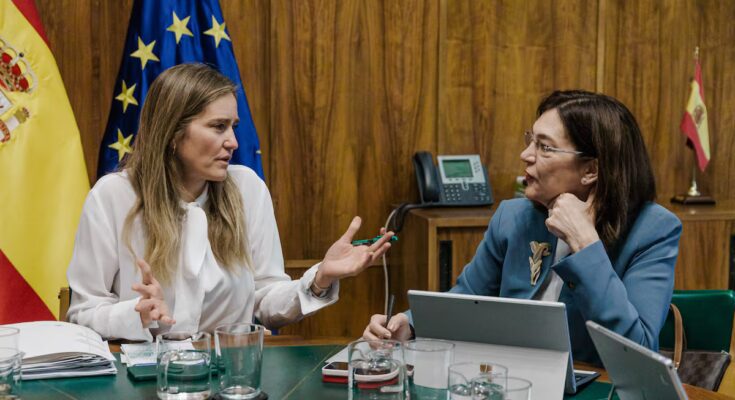On 29 October, the board of directors of the National Market and Competition Commission (CNMC) approved the controversial circular proposals which establish, respectively, the methodology for calculating the remuneration of the electricity distribution activity and the methodology for calculating the financial remuneration rate (TRF) of the electricity distribution (medium and low voltage) and transport (high voltage) networks for the regulatory period 2026-2031, and their referral to the Council of State. The proposals involved few changes compared to those initially proposed by the body chaired by Cani Fernández (from 6.46% to 6.58%, which represents an improvement of 12 basis points) and aroused the discontent of the large electricity companies, Iberdrola, Endesa and Naturgy, the first two integrated into the Aelec association, which had asked for a tariff higher than 7%. In the end, analysts managed to place themselves in a range between 6.7% and 7%.
According to various sources, however, one of the circulars (the one relating to the TRF) would have been sent to the Council of State without including the mandatory report from the Ministry for Ecological Transition, which would not have respected the timing of an evaluation procedure, since the new remuneration of the networks will have to come into force on 1 January next year, otherwise the current one would be extended for another six years, the regulatory period which ends on the last day of this year.
According to the CNMC version, “the deadline for issuing reports on the draft circulars on distributive remuneration and the financial remuneration rate expired on August 4”, but, however, – it adds – “the agency tried to wait as long as possible for the arrival of the ministry’s reports”. In the first case, the sentence arrived on October 10 and served for a second public hearing, at the end of which some of the changes requested by the department chaired by Sara Aagesen were made. However, having not sent the report on the second circular, that of the TRF, in time, the CNMC had to urgently send them both to the Council of State on 29 October without a mandatory opinion. The regulator recalls that “the circulars must be published on Boe by 31 December to avoid the extension of the previous tariff”, that of the regulatory period now expiring.
Several sources assure that the ministry has already issued it and, despite having formulated some observations on the proposal, “none is essential”. The CNMC assures that it will include it in the dossier and, “if there is time”, will send it to the Council of State. The point is that in this opinion (but not in the circular on the remuneration methodology) the Ecological Transition envisaged in the so-called Energy Policy Guidelines, a power for the Government to influence the regulatory proposals of the CNMC for regulated activities.
The word belongs to the Council of State
The stone is now on the roof of the State Council, whose task is to verify whether the circulars comply with the legal system. According to legal sources, since the ministry’s opinion was implemented late and, once the board of directors approved the circulars, this body has two options: to accept the inclusion of the ministry’s opinion in the file now or to return it to the CNMC which could resolve it peremptorily, accepting or not the transition recommendations (this question is not important, since the regulator is not obliged to accept the suggestions).
In a normal situation, the Council of State would simply return him, but given the rush and the money at stake, “he is under pressure”, political sources say. Nobody likes the situation that processing failure has created. The distribution companies, in fact, are the last ones interested in the distribution proposal, even if it is not to their liking, becoming a dead letter. “Well, it would no longer be worth developing a new circular that will come into force in a few months, but rather it would be necessary to stick to what was established for the current six-year regulatory period”, add the same sources. And there is a difference between the current financial remuneration rate (5.58%) and the one proposed starting in January (6.58%). Another issue is that the first circular, the one on the methodology for calculating salaries, which the sector rejects, would have been affected by the delay.
After the approval of its circular proposals, analysts had already warned that the CNMC had not received any reports indicating its opposition to the energy policy guidelines. What was not made clear is that the report is mandatory, regardless of its observations. The sector, which threatened to suspend its investments in Spanish networks if the regulator’s proposal was successful, had already lost hope in any miracle after the CNMC’s proposals.
The distributors (the large ones of Aelec and the small ones integrated into CIDE) had jointly opposed proposals which they had always considered insufficient. It so happens that before the CNMC began the process of approving the circulars, more than a year ago, the Ministry for Ecological Transition itself, then directed by Teresa Ribera, had already sent its guidelines to the CNMC asking for remuneration that would allow Spanish companies to compete.
Last Friday, after knowing the final content of the circulars, Aelec expressed “its deep concern about the revision of the new CNMC circulars”, since “they do not incorporate key aspects to guarantee the electrification of the country”. In this sense, through a press release, the association chaired by Marina Serrano, considered that the TRF proposal (6.58%) “is well below the cost of capital and European levels, discouraging investments in Spain at a critical moment for the construction of electricity infrastructure”.



